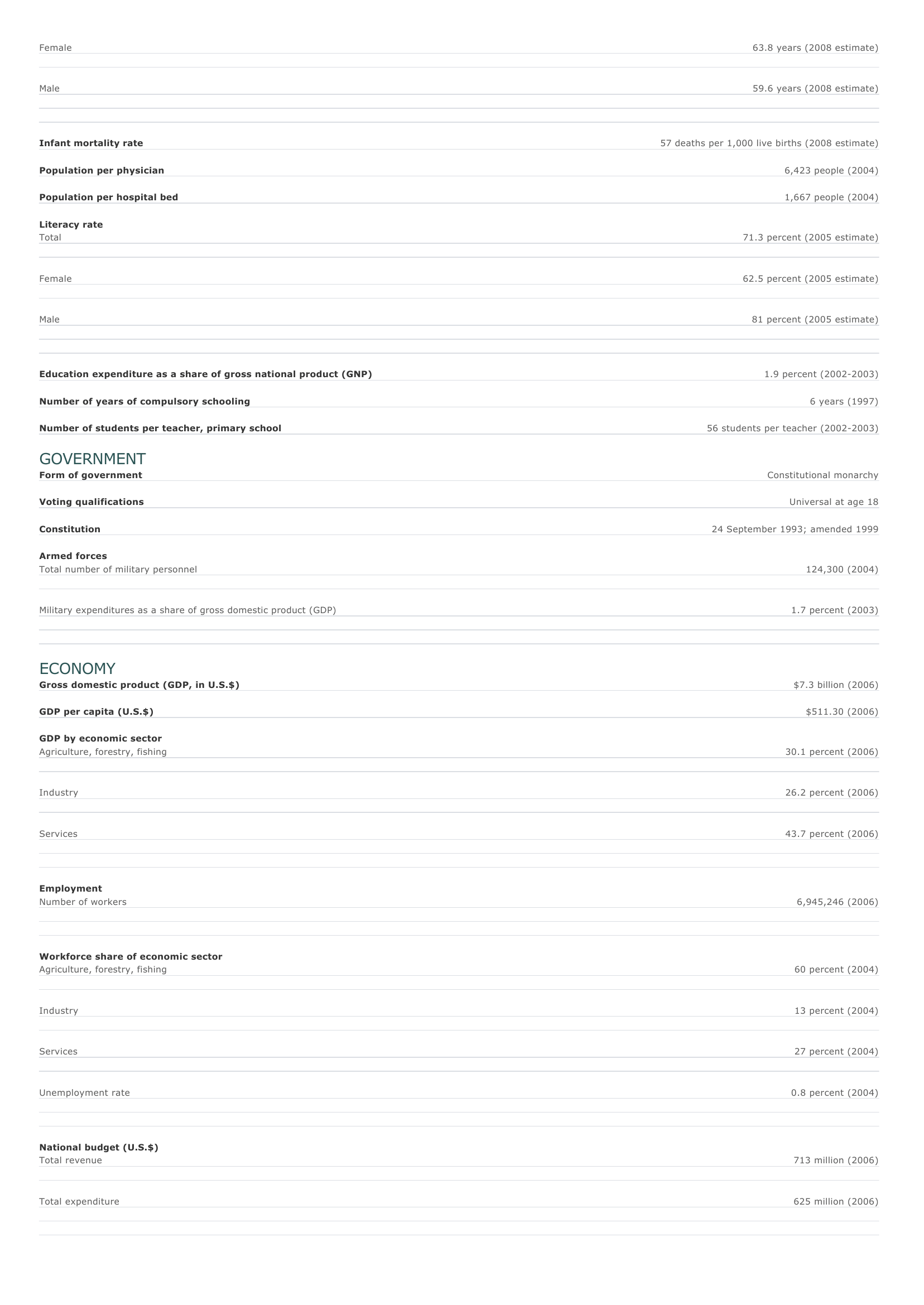Cambodia Facts and Figures. BASIC FACTS Official name Capital Area Kingdom of Cambodia Phnom Penh 181,035 sq km 69,898 sq mi PEOPLE Population 14,241,640 (2008 estimate) Population growth Population growth rate 1.75 percent (2008 estimate) Projected population in 2025 18,966,883 (2025 estimate) Projected population in 2050 23,965,562 (2050 estimate) Population density 81 persons per sq km (2008 estimate) 209 persons per sq mi (2008 estimate) Urban/rural distribution Share urban 20 percent (2005 estimate) Share rural 80 percent (2005 estimate) Largest cities, with population Phnom Penh 1,157,000 (2003 estimate) B ?tdâmbâng 171,382 (2002) Ethnic groups Khmer 90 percent Vietnamese 5 percent Chinese 1 percent O ther 4 percent Languages Khmer (official), French Religious affiliations Theravada Buddhist 85 percent Indigenous beliefs 4 percent Muslim 2 percent Nonreligious 2 percent O ther 7 percent HEALTH AND EDUCATION Life expectancy Total 61.7 years (2008 estimate) Female 63.8 years (2008 estimate) Male 59.6 years (2008 estimate) Infant mortality rate 57 deaths per 1,000 live births (2008 estimate) Population per physician 6,423 people (2004) Population per hospital bed 1,667 people (2004) Literacy rate Total 71.3 percent (2005 estimate) Female 62.5 percent (2005 estimate) Male Education expenditure as a share of gross national product (GNP) Number of years of compulsory schooling Number of students per teacher, primary school 81 percent (2005 estimate) 1.9 percent (2002-2003) 6 years (1997) 56 students per teacher (2002-2003) GOVERNMENT Form of government Constitutional monarchy Voting qualifications Universal at age 18 Constitution Armed forces Total number of military personnel Military expenditures as a share of gross domestic product (GDP) 24 September 1993; amended 1999 124,300 (2004) 1.7 percent (2003) ECONOMY Gross domestic product (GDP, in U.S.$) GDP per capita (U.S.$) $7.3 billion (2006) $511.30 (2006) GDP by economic sector Agriculture, forestry, fishing 30.1 percent (2006) I ndustry 26.2 percent (2006) Services 43.7 percent (2006) Employment Number of workers 6,945,246 (2006) Workforce share of economic sector Agriculture, forestry, fishing 60 percent (2004) I ndustry 13 percent (2004) Services 27 percent (2004) Unemployment rate 0.8 percent (2004) National budget (U.S.$) Total revenue 713 million (2006) Total expenditure 625 million (2006) Monetary unit 1 riel (CR), consisting of 100 sen Major trade partners for exports United States, Germany, United Kingdom, Singapore, Japan Major trade partners for imports Thailand, Singapore, Hong Kong SAR, China, Taiwan ENERGY, COMMUNICATIONS, AND TRANSPORTATION Electricity production Electricity from thermal sources 55.52 percent (2003 estimate) Electricity from hydroelectric sources 44.48 percent (2003 estimate) Electricity from nuclear sources 0 percent (2003 estimate) Electricity from geothermal, solar, and wind sources 0 percent (2003 estimate) Number of radios per 1,000 people 128 (1997) Number of telephones per 1,000 people 3 (2003) Number of televisions per 1,000 people 8.3 (2000 estimate) Number of Internet hosts per 10,000 people Daily newspaper circulation per 1,000 people Number of motor vehicles per 1,000 people Paved road as a share of total roads 0.58 (2003) Not available 30 (2000) 6 percent (2004) SOURCES Basic Facts and People sections Area data are from the statistical bureaus of individual countries. Population, population growth rate, and population projections are from the United States Census Bureau, International Programs Center, International Data Base (IDB) (www.census.gov). Urban and rural population data are from the Food and Agriculture Organization (FAO) of the United Nations (UN), FAOSTAT database (www.fao.org). Largest cities population data and political divisions data are from the statistical bureaus of individual countries. Ethnic divisions and religion data are largely from the latest Central Intelligence Agency (CIA) World Factbook and from various country censuses and reports. Language data are largely from the Ethnologue, Languages of the World, Summer Institute of Linguistics International (www.sil.org). Health and Education section Life expectancy and infant mortality data are from the United States Census Bureau, International Programs Center, International database (IDB) (www.census.gov). Population per physician and population per hospital bed data are from the World Health Organization (WHO) (www.who.int). Education data are from the United Nations Educational, Scientific and Cultural Organization (UNESCO) database (www.unesco.org). Government section Government, independence, legislature, constitution, highest court, and voting qualifications data are largely from various government Web sites, the latest Europa World Yearbook, and the latest Central Intelligence Agency (CIA) World Factbook. The armed forces data is from Military Balance. Economy section Gross domestic product (GDP), GDP per capita, GDP by economic sectors, employment, and national budget data are from the World Bank database (www.worldbank.org). Monetary unit, agriculture, mining, manufacturing, exports, imports, and major trade partner information is from the statistical bureaus of individual countries, latest Europa World Yearbook, and various United Nations and International Monetary Fund (IMF) publications. Energy, Communication, and Transportation section Electricity information is from the Energy Information Administration (EIA) database (www.eia.doe.gov). Radio, telephone, television, and newspaper information is from the United Nations Educational, Scientific and Cultural Organization (UNESCO) database (www.unesco.org). Internet hosts, motor vehicles, and road data are from the World Bank database (www.worldbank.org). Note Figures may not total 100 percent due to rounding. Microsoft ® Encarta ® 2009. © 1993-2008 Microsoft Corporation. All rights reserved.

























